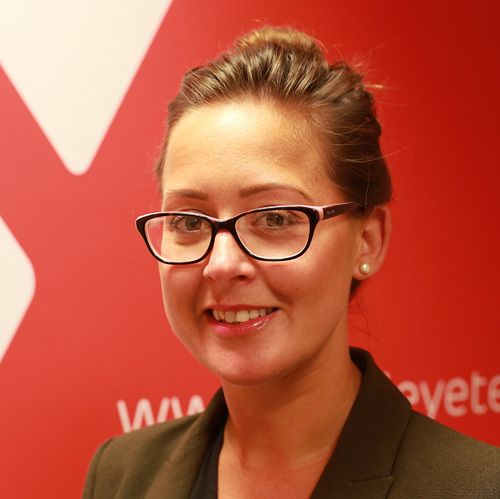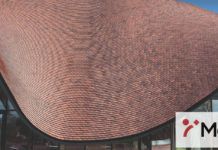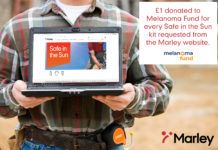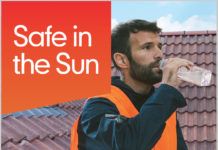

Since we started our Safe in the Sun campaign 12 years ago, sun safety in the roofing, cladding and wider construction industry has certainly improved for the better. Now, most main contractors, house-builders and large roofing companies have sun safe procedures, which include incorporating shaded areas in work sites, giving advice on covering up and providing free or discounted sun cream. Many building companies also require subcontractors to wear appropriate tops on site at all times.
However, there is clearly more work to be done when it comes to changing behaviour on site and ensuring outdoor workers take the necessary precautions. Worryingly, recent research by the University of Nottingham found that two thirds of construction workers who were outside for an average of nearly seven hours a day, thought they were not at risk of skin cancer, or were unsure if they were at risk, and more than half of them had been sunburnt at least once in the last year.
This is backed up by our own research which showed that 86% of construction workers make do with a lower than 30 SPF sun cream and many don’t use it at all. ‘I often forget’, ‘I haven’t got time’ and ‘it is too expensive’, were cited as the top three reasons why workers don’t regularly apply sunscreen.
The fact that the UK weather is unpredictable is also one of the reasons why people’s attitudes and behaviour to the sun here can be more complacent than in countries known to be hot and sunny. The University of Nottingham research, commissioned by the Institute of Occupational Safety and Health (IOSH), found there were misconceptions about the threat of UV in climates like the UK and a belief that cloud cover protected against solar radiation. In fact, the IOSH research found that just over 40% of workers thought there was no need to wear sunscreen on cloudy days.
These types of misconceptions are worrying at a time when skin cancer rates are still rising and 50 outdoor workers are dying from skin cancer every year. Yet many people in the UK only think of applying sun cream when they see it is very sunny, or feel strong heat from the sun. In fact, it is actually the UV rays we can’t feel which are harmful and they can still damage the skin on cloudy and overcast days. Figures from Cancer Research show that on overcast days 30 to 40% of UV radiation will still penetrate through cloud cover. If half the sky is covered in clouds, 80% of UV radiation still gets through.
Roofers at risk
Overexposure to UV, or ultraviolet rays (UVA and UVB), is the biggest cause of skin cancer but unlike heat from the sun, the rays cannot be seen or felt and can still pass through light cloud. Construction workers are thought to be most at risk because of the long periods of time spent outdoors, with some trades like roofers being up to nine times more likely to get skin cancer than other workers.
Raising awareness about high UV levels is a good way of encouraging better sun safety behaviour on site. Checking the UV index on the weather forecast, or on some of the available phone apps, is a good way to see whether you need protection that day. However, this isn’t practical on site so as part of this year’s Safe in the Sun campaign at Marley Eternit we are providing free UV colour changing wrist bands to all of our contractor customers. The white silicone bands carry the Safe in the Sun message and will change colour to red when continuously exposed to UV rays, acting as a visual reminder to take sun protection measures.
The legal responsibility to protect workers from sun damage applies to all employers under both the Health and Safety at Work Act and the CDM regulations, which require employers to protect outdoor workers from the weather. The revised 2015 CDM regulations also directly affect domestic projects and SMEs for the first time. This means that on sunny days, employers should ensure outdoor workers protect themselves as a matter of course. On cloudy and overcast days, if UV levels are 3 or higher on the index, or the wristband changes colour, then people need to wear sunscreen and cover up.
Research shows that the biggest changes to on-site behaviour come from sun safety training or education sessions, and a change in on-site culture so applying sun protection becomes as standard as wearing a hard hat. As part of our Safe in the Sun campaign, we are reminding construction workers and their employers about how to protect themselves from UV radiation:
For outdoor workers:
- Keep a shirt or jacket on and opt for tightly woven fabrics, which help to form a barrier to the sun’s harmful rays.
- Don’t leave exposed skin unprotected. Use sunscreen with an SPF of at least 30 and remember to reapply regularly.
- Wear a hard hat at all times, preferably with a brim and flap that will cover the ears and the back of the neck.
- Drink plenty of water and stay hydrated.
- Check your skin regularly for unusual spots and moles or changes to spots and moles.
For employers:
- Ensure all workers are briefed on your sun safety procedures.
- Check the UV index and ensure that if it is predicted to be level 3 or above that the necessary precautions are being taken on site.
- Discuss the misconceptions around UV radiation and provide employees with our free wristbands.
- Swap job tasks between workers to make sure everyone spends some time in the shade if possible.
- Make sure rest breaks are taken in shaded areas.
For more information about staying safe in the sun or to request a free UV wristband, contact Katie Prestidge on 01283 722289 or katieprestidge@marleyeternit.co.uk



